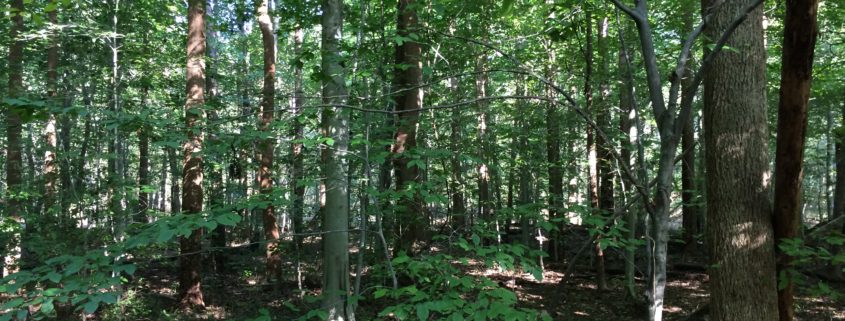Using Virginia’s Natural Community Research to Guide Stewardship Activities
Article by FMN Joe Gorney, photo by J. Quinn
As Master Naturalists, we sometimes help reclaim vegetated areas from the clutches of non-native invasives. At the end of this process, we’re often confronted with a degraded and/or blank slate in need of enhancement. But deciding what to plant can be a challenge. Optimally, we’d use a mixture of upper-story trees, mid-story trees, shrubs, and herbaceous plants to create a well-balanced plant community. The Virginia Department of Conservation and Recreation maintains a publication entitled “The Natural Communities of Virginia: Classification of Ecological Groups and Community Types,” which includes information regarding the more than 300 natural communities that cover Virginia: https://www.dcr.virginia.gov/natural-heritage/natural-communities/. While the publication is an amazing resource, navigating all of that on-line information to find the appropriate community and then deciphering said information to decide what to plant can be a challenge, so much so that people might be tempted to either: a) give up; and/or b) default to the “TLAR” method of plant selection (That Looks About Right).
Faced with that scenario and motivated by some long-term restoration work in Arlington County, Glenn Tobin, an Arlington Master Naturalist since 2016, worked with ecologists and biologists from Arlington County, DCR’s Division of Natural Heritage, and several other groups. He led a year-long effort to translate DCR’s publication into readily-accessible and practical guidance for people engaged in ecological restoration efforts. The original publication was pared down to the nine plant communities endemic to Northern Virginia. The resulting guidance has been published in a website entitled “The Natural Ecological Communities of Northern Virginia.”
(see: https://www.novanaturalcommunity.com/).
The website contains a list of the nine forest communities we might encounter, key concepts to identify those communities, a dichotomous key for community identification, downloadable summary descriptions of each community, Excel spreadsheets with more detailed information, and a list of some natural community misfits. Species are included within each community and categorized by abundance (sparse, rare, restricted, common, dominant).
The website is intended as a guide, and not a “cookbook,” a guide that can help us formulate planting recommendations to enhance the ecological health of an area. The plant communities were selected to establish a desired end state for restoration. The information does not address edges or meadows, although the Clifton Institute in Warrenton is developing some information regarding meadows (https://cliftoninstitute.org/). If you’d like to see a presentation regarding the new website, log onto the VMN Continuing Education Webinar Series webpage and click the link from May 7, 2021. (Continuing Education Webinar Series – Virginia Master Naturalists)
For further information about integrating plant communities into your landscape, I also recommend the following books:
- Planting in a Post-Wild World: Designing Plant Communities for Resilient Landscapes, by Thomas Rainer and Claudia West.
- The Living Landscape: Designing for Beauty and Biodiversity in the Home Garden, by Rick Darke & Doug Tallamy.
- Garden Revolution: How Our Landscapes Can Be a Source of Environmental Change, by Larry Weaner and Thomas Christopher.
Other valuable resources include:
- The Blue Ridge Partnership for Invasive Species Management (Blue Ridge PRISM): https://blueridgeprism.org/training-materials/ (see the recording of the Spring 2020 meeting).
- Plant NOVA Natives Plant Northern Virginia (NOVA) Natives (plantnovanatives.org).
Summer would be the perfect time to explore this information, so that you’ll know what to plant come Fall. Happy reading and good luck creating healthy landscapes throughout our communities and within our backyards., photo by


